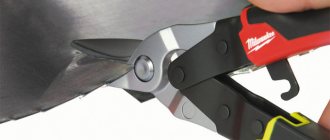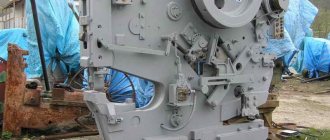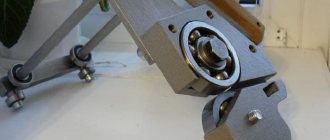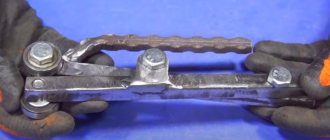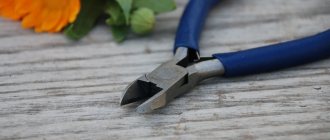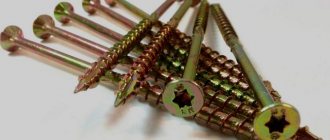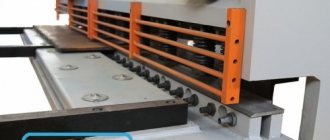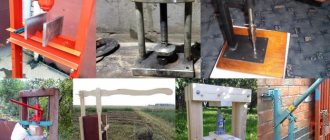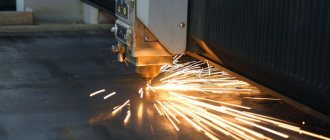Cutting metal with hand scissors
TO
category:
Metal cutting
Cutting metal with hand scissors
Next: Cutting metal with a hacksaw
Manual musical instruments are used for cutting steel sheets with a thickness of 0.5 - 1.0 mm and non-ferrous metals up to 1.5 mm. Hand scissors are made with straight and curved cutting blades,
According to the location of the cutting edge of the blade, hand scissors are divided into right and left.
Rice. 1. Elements of scissors
Right-handed scissors are those in which the bevel on the cutting part of each half is on the right side. Using right scissors, cut along the left edge of the product in a clockwise direction.
Left-handed scissors are those in which the bevel on the cutting part of each half is located on the left side. These scissors are used to cut along the right edge of the product counterclockwise.
When cutting a sheet with right-handed scissors, a mark is always visible on the metal being cut. When working with left-handed scissors, in order to see the mark, you have to bend the cut metal with your left hand, passing it over your right hand, which is very inconvenient. Therefore, sheet metal is cut in a straight line and along a curve (circle, rounding) without sharp turns with right-handed scissors.
The scissors are held in the right hand, grasping the handles with four fingers and pressing them to the palm; The little finger is placed between the handles of the scissors.
The clenched index, ring and middle fingers unclench, straighten the little finger and, with its effort, move the lower handle of the scissors to the required angle. Holding the sheet with your left hand (Fig. 2, b), feed it between the cutting edges, directing the upper blade exactly in the middle of the marking line, which should be visible when cutting. Then, squeezing the handle with all fingers of the right hand, except the little finger, they cut.
In Fig. 2, c, d shows techniques for working with scissors.
For straight cutting of metal of small thickness, hand scissors are used, one handle of which is clamped in a vice.
Chair staves differ from manual ones in their larger sizes and are used when cutting sheet metal up to 3 mm thick. The lower handle is firmly clamped in a bench vice or fastened (hammered) onto a table or other rigid base. For cutting sheet steel up to 3 mm thick, chair scissors with a stationary fastening are used (Fig. 3, c).
Chair shears are low-productive and require significant effort when working, so they are not used for cutting large batches of sheet metal.
Manual small-sized power music books. Innovator A. N. Vasiliev created small-sized power shears for cutting sheet steel up to 2.5 mm thick, rods, bolts (studs) with a diameter up to 8 mm. The dimensions of these scissors do not exceed the dimensions of standard hand scissors (Fig. 4). For cutting, the handle is secured in a vice, and the handle (working) is activated. The working handle is a system of two levers connected in series. The first lever, on one arm of which the knife is fixed, is connected to the handle with a screw.
Rice. 2. Working with scissors: a - position of the hand on the handle when cutting with scissors, b - with straight blades, c - with curved blades, d - cutting out the internal curved contour
Rice. 3. Scissors: a - chair scissors, fixed in a vice, b - hand scissors, fixed in a vice, c - chair scissors on a wooden base
Rice. 4. Small-sized power shears
Rice. 5. Lever shears
Rice. 6. Flying scissors
The second arm of the lever, which is the handle of ordinary scissors, is shortened and ends with a hinge, or the scissors handle itself. The end hinge of the handle is connected to the handle using a double-hinged link. This lever system approximately doubles the cutting force compared to conventional scissors of the same size. The scissor blades are replaceable and attached to the levers with hidden rivets.
These scissors also have a device for cutting rods with a diameter of up to 8 mm. The device has discs with holes mounted on scissor arms and is a regular scissors, but with specially shaped knives (hardened bushings). These knives are replaceable and are inserted into the disk socket. For cutting bolts (piles). in the bushings of one of the disks there is a groove (several threads), which protects the threads of the bolts from being crushed during cutting.
Small-sized power shears provide good cutting quality.
Lever shears (Fig. 5) are used for cutting sheet steel up to 4 mm thick, aluminum and brass up to 6 mm. The upper hinged knife is driven by a lever. The lower knife is stationary.
The knives are made from U8 steel and hardened to a hardness of HR.C 52 - 60. The sharpening angles of the cutting edges are 75 - 85°.
Before work, check whether the rubbing parts are lubricated, whether the lever moves smoothly, and whether there is a gap between the cutting edges.
When cutting metal, grab the handle of the lever with your right hand and smoothly move it to the upper position, while the upper knife 3 moves upward. Then the sheet is laid so that the left hand holds it in a horizontal position, and the cut line is in the field of view and coincides with the blade of the upper knife. By moving the hand, lower the lever with the knife down until part of the metal is cut through, after which the lever is moved to the upper position. Next, slightly lift sheet 4 with your left hand, move it along the line along the cutting edge of the upper knife and repeat the cutting technique until it is completely cut. The scissors provide a cut without dents, cuts along the edge and sufficient accuracy.
Fly shears are widely used for cutting sheet metal with a thickness of 1.5 - 2.5 mm with a tensile strength of 450 - 500 MPa (45 - 50 kgf/mm2) (steel, duralumin, etc.). These scissors cut metal of considerable length. Lever shears have a cast iron frame and table. A lower stationary knife is built into the table, and an upper movable knife with a curved cutting edge is fixed in a knife holder. The upper movable knife has a counterweight that balances the knife holder with the knife.
The size of the workpieces to be cut is pre-marked or limited by an adjustable stop, for which the stop is first set at the required distance from the cutting edge of the lower stationary knife. During cutting, the sheet is tightly pressed with its side edge against the stop, and with the other edge against the spring stop. After this, by turning the handle away from you, the sheet is pressed tightly from above with a clamping bar and, lowering the upper nose with knife holder 6, the workpiece is cut.
When lowered, the knife holder rests against a spring stop. Rearrangement of the stop is carried out using the handle.
Shears with inclined knives (guillotine) allow you to cut sheet metal up to 32 mm thick, sheets with dimensions of 1000 - 3200 mm, less often strip products, as well as sheet non-metallic materials.
What are metal scissors
From the name it becomes clear for what purposes the devices in question are intended. Like regular scissors, metal cutting devices are designed only for working with sheet materials. It is impossible to cut pipes, angles and profiles with metal cutting devices, since they are not designed for this, and simply will not cope with this task.
Structurally, hand-held metal scissors consist of handles and cutting knives. The mobility of the knives is ensured by the mounting bracket. The sharpening angle of cutting knives is 60-75 degrees. This sharpening angle ensures high performance with minimal effort. The large sharpening angle means that the tool can be used for cutting hard metal sheets. The knives in relation to the handle are located at an angle of 7 to 12 degrees.
The knives of the tools in question are made of alloy (chrome-vanadium) or tool steel, which has a positive effect not only on the quality of the cut, but also on the service life. When the blades on knives become dull, they can be sharpened. The tool handles are covered with plastic, rubber or silicone material for ease of work.
This is interesting!
Many people use hand-held metal shears to cut thin sheet metal, such as galvanized sheets or corrugated sheets, and do not know that there are different types of such tools. Depending on the task at hand, it is necessary to select the appropriate type of tool.
Types of tools
Before you buy hand scissors for cutting thin sheet material, you need to understand their types. To carry out the relevant work on processing sheet steel, you need to take the appropriate tool, which will allow you to achieve the necessary results. What are the devices in question or their types, we will find out further.
- A straight cutting tool is the simplest type of device, which is designed for cutting large circles and straight cutting of material
- Mechanical with curved blades - used for cutting holes, as well as for obtaining cuts of different shapes
- Finger blades with thin blades - used to produce cuts of various shapes. The blades on finger scissors have different positions relative to each other. It follows that tools are divided into left and right, and depending on the task at hand, it is necessary to use the appropriate type of device
- Chair saws - used for cutting thick sheet steel. They cope with steel thicknesses up to 2-3 mm. When cutting thick sheet steel, effort must be made, so the design of the devices has a special bend. This bend is necessary in order to hook the tool to the workbench, thereby ensuring that the upper handle is pressed with high force, increasing the cutting force
- Power - another type of device for cutting sheet metal with a thickness of 2.5 mm. Power mechanical scissors consist of two levers, which are fixed using a hinged bracket. Power tool models come with replaceable discs and blades that can be used to cut metal rods up to 8 mm thick
- Lever scissors are professional models of scissors that are attached to a workbench. The design of such devices is such that one blade is movable and the other is fixed. The movable blade is driven by a handle on the tool. They are used for cutting aluminum, steel, copper, brass, etc. The maximum thickness of steel reaches 4 mm, and brass, copper and aluminum up to 8 mm
All types of scissors are divided into professional and amateur. They differ not only in price, but also in quality. Professional models are made from high-quality materials, so they are intended for constant use. They have a long service life and are 2 times cheaper than amateur ones. Amateur ones are intended for infrequent use, since low-grade types of steel are used for their manufacture.
Variations of the exercise
Once you have mastered scissors, you can move on and try other variations of this exercise.
- Stretch your arms along the floor and lift your straight legs 10–15 cm from the floor surface. As you exhale, lift your left leg up, keeping it straight. As you exhale, lower it down. Repeat with your right leg.
- You can try the so-called static scissors. Simply lift your legs straight off the floor and maintain this position for a minute.
- The exercise can be performed with weights. After you can easily do 2 minute approaches, put on special weights weighing 0.5 kg on your legs. This will give the muscles additional stress and allow you to achieve even more impressive results. The main thing is to make sure that your lower back does not come off the floor.
For best results, perform scissors 3-4 times a week, not forgetting other exercises to strengthen your abdominal muscles. An integrated approach is very effective. After just 2 months, you will see that your stomach has noticeably tightened.
Manual models of metal scissors and their manufacture
The manufacturing process of hand scissors involves the use of two options:
- Forging
- Casting
Models differ in price. Forged devices are much more expensive than cast ones, but they are much more reliable and durable. To make the blade durable, it is subjected to additional heat treatment. Hardening the cutting part prevents dulling of the cutting part, so it is extremely rare to sharpen this type of tool. After sharpening, the blades will dull much faster.
Cast scissors are suitable for farming, they are inexpensive and do an excellent job. With frequent use of scissors, the blade quickly becomes dull, so they need periodic sharpening. This tool can only cut thin sheet steel up to 2 mm.
This is interesting!
The hinge mechanism on hand scissors consists of two parts, which is done specifically to double the applied physical force.
Manufacturers also produce lever products that are made from two different materials. The cutting part is made of high-quality material, which increases their service life. The handles of such devices are made of ordinary steel, which has a positive effect on the cost of the tool. Using lever shears allows you to cut metal without much effort.
When purchasing hand scissors, you need to consider the placement of the knives. They are straight, as well as left and right. Straight ones are designed for smooth cutting, as well as cutting out large round shapes. As for the left and right shapes of the blades, here you need to know the following:
- Left - used to make cuts in the left direction. The left scissors should be used primarily while holding them in the right hand. When working with a tool with left-handed blades, the left side of the blades enters from below
- Right - used when it is necessary to bend to the right side. When working, you should hold such a tool in your left hand. When cutting with scissors, the right side goes under the sheet from below, which allows you to make an even cut
To make it easier to distinguish them, manufacturers paint the handles in different colors. The right scissors are painted green, and the left scissors are painted red. When using hand-held cutting devices, everyone has encountered the fact that when cutting a long sheet, the plane becomes bent and bent. This usually happens when using scissors with a symmetrical arrangement of knives. To prevent creases from forming, when cutting a long sheet of steel, you need to use a tool with asymmetrical knives.
This is interesting!
Instruments with asymmetrical knives are extremely rare on sale.
The reason for such low popularity is their high cost. However, in order to make an even and neat cut, it is recommended to buy just such metal scissors with asymmetrical blades. What can be cut with hand metal scissors:
- Galvanized steel
- Corrugated sheet
- Metal tiles
- Sheet metal
- Steel mesh
- Linoleum
- Rubber
- Ruberoid
The advantage of hand-held metal shears is that they cost 10 times less than power tools.
Electric scissors for fast and precise cutting of sheet material
Accuracy and accuracy of cutting with hand scissors is ensured only by choosing the right tool. In addition to manual scissors, manufacturers also produce electric scissors. The power tool does not require any physical effort to cut sheet material, since the electric motor is responsible for this action. There are two types of electric metal shears:
- Punching or die-cutting - structurally they have no resemblance to manual ones
- Knife - similar to hand tools, and their work is ensured by the mobility of one blade
Die-cut
received this name due to their operating principle. They are used for cutting sheets of corrugated sheets and metal tiles. The advantage of such devices is their ease of use and operational efficiency. When cutting through a steel sheet, sparks do not occur, and the roof covering does not deform. That is why it is recommended to abandon the use of an angle grinder when cutting thin-sheet material, replacing it with manual or electric scissors, or even better, buy an attachment for a drill for cutting metal.
Electric cutting scissors can not only cut straight, but also cut out various curly patterns. If you plan to cut a shape in the center of the sheet, then first you need to drill a hole and then install the cutting edge of the scissors into it. They work on the principle of a hole punch, and a movable mechanism—a punch—is responsible for punching through steel. When piercing steel, the knife moves very quickly, so the possibility of deformation and bending of the sheet is excluded.
In addition to cutting (or mortise) scissors, there are also knife scissors
. They are also called sheet or spline. They are very similar to manual ones, only they consist of movable and stationary knives. The movable blade moves due to an electric drive, making reciprocating movements. They are suitable not only for making straight cuts, but also for curved ones.
During operation, such scissors do not create waste, but they have a drawback - they jam the corrugated sheets. It is recommended to use them exclusively for cutting smooth sheet materials such as galvanized sheets, tin, etc. During operation, only the movable cutting knife becomes dull, which must be sharpened and replaced when worn.
Sheet shears have one fixed blade and the other a movable one. Slotted ones differ from them in that they have two fixed knives at the bottom and one movable one at the top. When using spline tools, chips are formed, the size of which does not exceed a few millimeters. The shavings are rounded when working with scissors and go to the side. You can work with a spline tool not only on the smooth surface of sheet materials, but also on corrugated sheets and metal tiles.
We pump up the press while lying on a ball
Choose a ball large enough to allow your feet to form a 90-degree angle. Next, sit on the ball and move your legs forward so that your lower back rests on the top of the ball. Place your hands around the back of your head. Raise your body until you feel your abdominal muscles tense and contracted. Return to the starting position. Repeat 10-12 times. It is important not to use your arms to help your upper body complete the exercise. Otherwise, the back muscles will work, not the abdominal muscles!
Delicious oatmeal and honey pie: a great dessert recipe without sugar and flour
Better than other sisters: by highlighting a favorite, a father fosters success in children
Neon French: a spring manicure that can be done without going to the salon
Why do you need guillotine shears?
There is another type of scissors, which also belongs to the group of hand tools. They're called
guillotine, which consist of a frame, as well as a fixed knife and a movable blade. Due to their design, they are also called tabletop or stationary. To cut sheet material, it is necessary to place the sheet on the knife according to preliminary markings. The sheet is cut by lowering the cutting blade.
This type of tool is suitable exclusively for cutting in a straight direction. They are not suitable for circular cutting, so you should choose a tool depending on its purpose. Guillotine shears are used in industry when large volumes of work are performed. Manufacturers also produce hydraulic guillotine tools for cutting pipes, profiles and other compact non-sheet materials.
What muscles does it use?
The exercise has a particular effect on the abdominal and thigh muscles. Most work during its execution:
- abdominal muscles responsible for the abs: rectus, oblique and transverse;
- vastus lateralis;
- rectus femoris muscle;
- adductor magnus and longus muscles;
- hamstring biceps.
Muscles that are most involved when performing the scissors exercise
How to choose scissors for cutting metal
Choosing a tool is the most important undertaking, since the purchase determines the ability not only to do the job, but also to do it efficiently. Every craftsman should have a pair of metal scissors in his arsenal. The prices for these devices vary, so you should choose depending on the tasks at hand. If you need to cut reinforcement, it is better to choose hydraulic guillotine shears, and for cutting galvanized sheets, ordinary ones with straight blades are suitable.
Which scissors to choose for the job depends on the technological tasks, so you need to focus on the following parameters:
- The location of the blades is left and right. Depends on what types of cuts you plan to make
- The shape of the blades is straight and curved. Scissors with straight blades are convenient for cutting in a straight direction, and curved blades can be used to make curved and shaped cuts.
- The capabilities of the tool depend on the material from which the device is made. They are cast, forged, and mixed
This is interesting!
Often, a decrease in the performance of scissors occurs not due to dulling of the blades, but due to a violation of the distance between the knives. The distance increases due to the loosening of the hinge joint under heavy loads. To improve the quality of metal cutting, the tool must be periodically adjusted.
Working with hand scissors is not difficult if you choose them correctly for certain jobs. Once you try a power tool in action, you probably won’t want to go back to hand tools. The only advantage of manual devices is that they are not expensive, so it is worth buying them so that you can use them at any time to cut thin-sheet materials. The video below explains in detail how to use the tool in question correctly.
To summarize, it should be noted that the devices in question are manufactured according to the relevant standards GOST 7210-75. To choose the best scissors, you don’t need to look for a rating of the best, since price is an indicator of quality. However, if you do not choose the right tool for the appropriate type of work, then even high quality and high price will not help.
